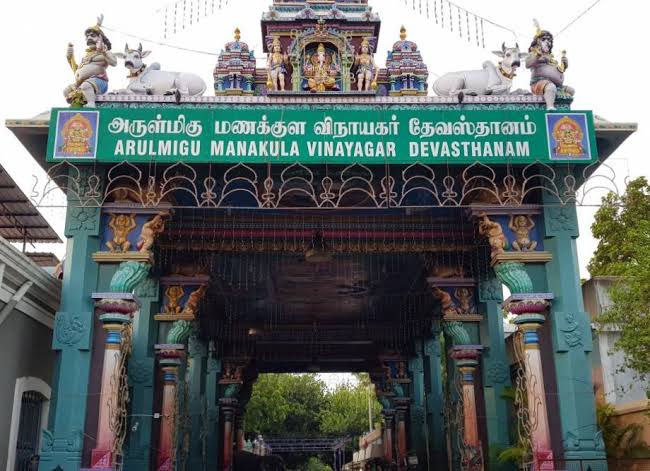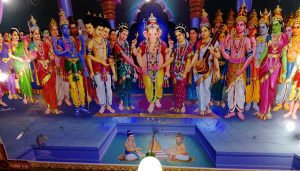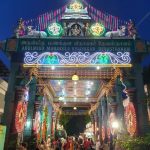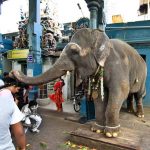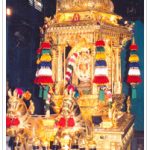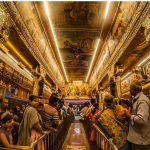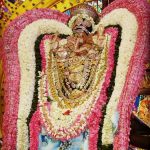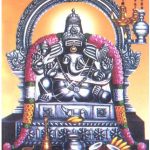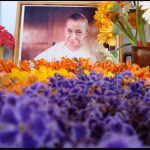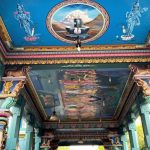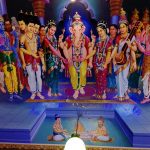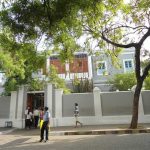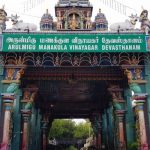
Mana Kula Vinayagar main Deity
Manakula Vinayaka Temple is one of the famous Ancient Temple in Puducherry, The temple is 400 meters West of Bay of Bengal Sea, 165 Km South of Chennai. The main deity Manakula Vinayaka of this Temple is facing east. This Temple is called as Manakula Vinayaka, as that time there was pond (Kulam in Tamil) on the western side of this Temple and due to proximity of Sea, pond was full of sand (Manal in Tamil), hence it was called as Mana Kula Vinayagar. Presently the Temple is built in 7913 sq. ft. with outer Mandapam, Raja Gopuram, Dwaja Sthamb (18ft tall gold plated), The presiding Deity Moolavar in Sanctum blesses his devotees with four hands, the top two holding Angusam, Pasam and the right low hand with Abayadana muthra and the left one Varadhana muthra. On the north side of the sanctum, Komugi is kept for Abhisheka water will come out and a small Temple for Sri Chandikeswar. On the Southern side, Prahara for walk to go to round the Ardhamandapam and Sanctum area about 106.56 sq. mt. donated by the Mother of Sri Aurobindo Ashram for extension on 25.12.1968. Now, on the Western side of the Prahara on the left hand side Sri Bala Vinayagar Temple below the silver vimana and on the Eastern side of the Prahara on the right hand side Sri Balasubramaniar (Sri Kartikeya) Temple below the silver vimana were found. Next to North Prahara entrance on the right hand side is Marriage Mandap, the place wherein used for all kind of Poojas, Homams, Brahmothsavam and Pavithrothsavam were performed to the Urchavamurthy, during the festival days. Different kind of vahanas kept safely at vahana Mandap nearby the temple.
Sthala Puran of Manakula Vinayaka Temple
Prior to French regime, the Temple is now was called weaver street and was renamed as Orlean street by them. This place was also part of the town where French and white people lived. They made every effort to remove the deity from this place and went even to extend of throwing the deity in sea and every time he came back to the same place, where the temple is now. Later the temple was built near the Bay of Bengal shores as per the Ganapathy Agamam and was named Bhuvanesa Vinayagar Temple.
The Golden Chariot:
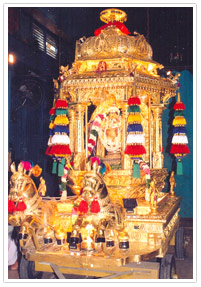
Golden Chariot
The Golden Chariot was made purely on the basis of collection of donations from the devotees. The total weight of the Gold used in this chariot is 7.5 kg with the estimate of around Rs.35 lakhs. The height & breadth of the chariot is 10 ft & 6 ft. The chariot was fully made up in teak wood covered by copper plates duly engraved with beautiful art works and the plates duly attached with golden rakes. At first the running of the said Golden Chariot was held on 05-10-2003 in a grand manner. At present most of the devotees are very much interested to fulfill their prayer by pulling the Golden chariot inside the temple on payment of fixed fees. Once in year i.e. on Vijayadhasami (Dussera) day the said Golden Chariot run outside of the temple i.e. only in the maada veedhis (Streets surrounding Temple on all 4 directions).
Inside colour paintings in Temple
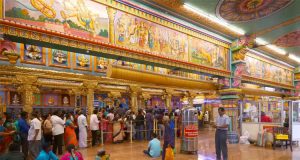
Art Inside Temple
In the front Mandap vithanam and inside historical scene have been painted taking the services of renowned painters. Some of them are Birth of Lord Vinayagar, killing of daemon Kayamuga Sura, Vinayagar marrying Siddhi and Buddhi, Vinayagar blessing Nambiyandar Nambi and so on.
Vinayaka with Sidhi Budhi Marriage. Roof top painting
Thollaikkathu Siddhar (Sage)
Nearly 300 years before a sage standing 6ft tall, broad forehead, glittering blissful eyes, big hole bearing ear, small pot bellied with hand extending up to knee cap and hands with lotus regai (lines), guru medu and sanimedu at a height showing arul gnana ragai. He got enlightenment from this deity and attained Samadhi in this Temple. From then on people bring their new born babies here for worship before going to any other temple.
The Sattology of Manakula Vinayagar Temple of Puducherry
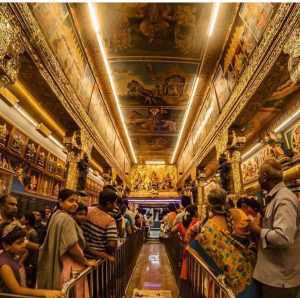
In front of main Sanctum
LONG, ago when Europeans ruled Pondicherry, there lived an atheist who was a bosom friend of the then Governor of the state Joseph Dupleix. No one knows for certain whether the governor and his friend were Dutch, Portuguese, English or French, for these were the four who ruled this historically renowned place at different times.
“This Pillaiyar is a very powerful deity. No force on earth can destroy Him”.
Impressive shrine for Lord Ganesha
The Manakkula Vinayakar Temple in Pondicherry is as famous a landmark as Sri Aurobindo Ashram. PREMA NANDAKUMAR traces its history.
The awesome processional deity of Manakkula Vinayakar
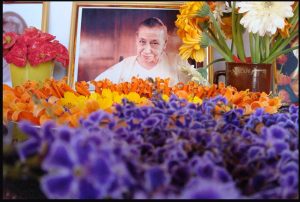
Mother Mirra
GOING UP the steps to worship Manakkula Vinayaka in Pondicherry, I have always wondered how this deity has a different tale to tell. Whereas all other temples report of being diddled out of their endowments by unscrupulous people down the centuries, Manakkula Vinayakar has actually increased his temple space. As you turn left, a plaque with a gold sheen confronts you with the contents that are found both in English and Tamil:
“With the blessings of The Mother of Sri Aurobindo Ashram, Pondicherry, A gift of a piece of land measuring 106×56 sq.m., was made for widening the Southern side of Parikrama Arulmigu Manakkula Vinayagar Temple on 21.01.1969.”
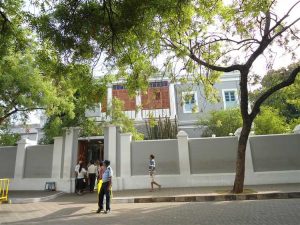
Sri Aurobindo Ashram
It appears that when the Sri Aurobindo Memorial Fund Society purchased the Montbrun House adjacent to the temple, the Mother sent word to the Temple authorities that she would like to offer a portion of land to the Temple so that the devotees could have a comfortable parikrama to go round the sanctum (Pradakshina). This proposal was accepted eagerly and now we have a beautiful structure with more decorations and paintings. The Mother, who was herself a spiritual Power, had a deep devotion for Manakkula Vinayaka and kept with her images of Ganesha, to help her tide over monetary problems. She has also gone on record to reveal how He manifested before her as a flame of golden light encircled by a very brilliant golden aura while retaining his traditional image of an Elephant-headed God. Manakkula Vinayaka insinuated himself with poetic grace into modern Tamil literature by inspiring Subramania Bharati to write Vinayakar Naanmani Maalai. Other great devotees who have written poems on Manakkula Vinayaka include Vannacharbham Dandapani Swamigal, Jaffna S. Kandiah Pillai and Nagalinga Swami.
There is an attractive neatness about the temple. Once we enter the parikrama, we go straight to sanctum and whatever be the time of the day, it is a pleasure to watch the worship with lighted camphor, glowing Diyas / Deepam and recitations. The temple, situated on the seashore, is more than 500 years old and is on a street, which was originally populated by weavers. However, with the occupation of the French, the temple began facing problems. The Christian priests would not allow the public procession of the deity on Sundays and on Easter, and made the Governor sign an order to that effect in 1701. However, Hindu devotees rebelled when the government decided to demolish the Temple structure. Skilled artisans joined the strike and people decided upon a mass exodus from Pondicherry. The Governor, Francois Martin came to an agreement and people gave up their plans after being promised that there would be no hindrance to temple worship.
In 1708 some Christian priests led Adi Dravidas into the Temple and caused untold destruction to the Temple property. Once again the Hindus of Pondicherry went on a strike and wrested an assurance from the Governor that there would be no interference in the religious activities of the Hindus. A royal spire of 24 feet and a flagstaff greet us and lead us to a huge mandapam held by 12 pillars. Close to the roof, one sees different Vinayaka figurines indicating the various appearances evoked in innumerable Temples in India, Japan, Java, Nepal and China. Some of the figures, like the one in which Parvati is holding Vinayaka as a baby on her hip, have been imaginatively created. The little niche in the West corner has Balaganapathi with mango, jackfruit, plantain and sugarcane in his four hands. In the Northwest corner an identical niche has Balasubramania as the deity. Being a child with two hands, he is seen holding a Lotus in his right hand.
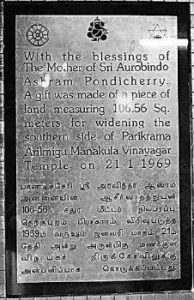
Land donation agreement by Mother
The shining plaque that announces the Mother’s gift of land to the Temple
On the Northern side, we have the Rest-Hall where we see Vinayaka with his consort. There is a bigger hall where we have an array of processional deities. Among them are Haridra Ganapati, Nartana Ganapati, Lakshmi Ganapati, Subramania with Valli and Deivayanai, and a Spatika Lingam.
Adjacent to this wall is a large mandapam where Abhishekam for the processional deities (Utsava Moorthy) takes place. Arrayed here are the mounts used for the processions.
They are Surya Prabha, Chandra Prabha, the Peacock, Adikara Nandi, a silver Elephant, the Kalpavriksha (Wish-yielding Tree) and a silver Bandicoot. There are also three temple chariots. One is made of wood and another of silver, while the third one is gold-plated.
The Vinayaka in the sanctum is a majestic figure. The sanctum also has a smaller Vinayaka image and that of a serpent helix. The worship of Manakkula Vinayaka goes on almost throughout the day. Every month witnesses a different set of festivals too, with a special accent placed on Vinayaka Chathurthi. The 18-day Brahmotsavam is colourful and there is plenty of public participation.
Both Manakkula Vinayakar Temple and the Sri Aurobindo Ashram have made Pondicherry a dynamo of religious and spiritual activity and one of holiest pilgrim centers in the country today.
A small clip on Elephant Lakshmi circumnavigate followed by Shri Ganesha on Golden Chariot.
- Arch while entering temple
- Art inside Temple
- Elephant Lakshmi blesses the visitors
- Gold_Chariot
- In front of Sanctom
- Main Deity
- Manakula Vinayagar Mother
- manukula-vinayagar main deity
- Mother Miira
- Roof Top painting inside Temple
- Roof_painting_at_the_entrance_of_Manakula_Vinayagar_Temple
- Aurobindo Ashram
- Welcome Arch
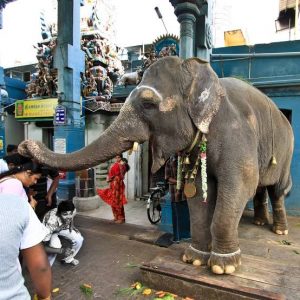
Elephant Lakshmi blesses the visitors
All information entered is personal to the author. Any modification or changes must be addressed to the author.


